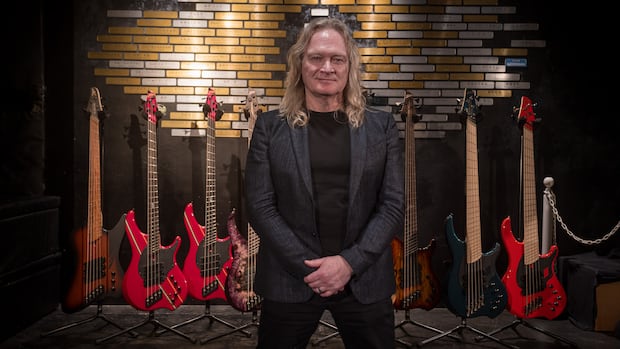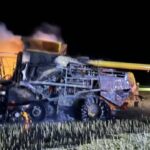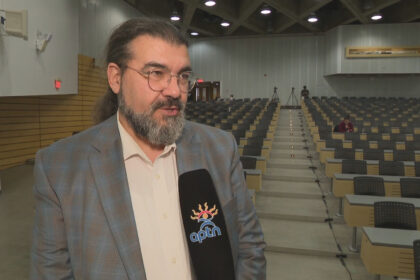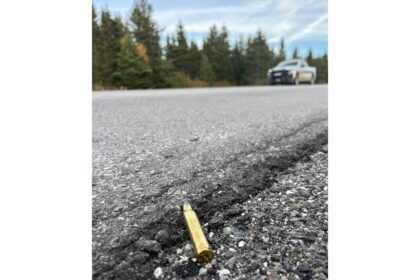Saskatchewan·Creator Network VideoSheldon Dingwall started building guitars in the 1980s, and has built a global success story. But it didn’t come easy. A devastating fire destroyed everything 29 years ago. With help from the community, Dingwall was encouraged to keep going and has now grown his company’s brand into a global name.Dingwall Guitars began in the ’80s in a small Saskatoon workshop, and now it’s an international playerAnna-May Zeviar · CBC News · Posted: Oct 08, 2025 6:00 AM EDT | Last Updated: October 8Sheldon Dingwall, founder of Saskatoon-based Dingwall Guitars, stands in front of a guitar display in Tokyo, Japan. (Submitted by Felipe Gomez)CBC Saskatchewan’s Creator Network is a place where young digital storytellers from diverse backgrounds can produce original video content to air on CBC and tell stories through their own lens. Get in touch or pitch your own story here.It’s a global name in electric guitars and basses, but unless you’re in the music industry, you may not be familiar with Dingwall Guitars.The bespoke instrument-making company was founded in Saskatoon in the 1980s by Sheldon Dingwall, who still serves as the company’s CEO.”We have been building electric bass guitars here in Saskatoon for the last 40 years. Saskatoon’s our home,” Dingwall said. “It’s also the birthplace of the Canadian electric guitar industry. So it’s really cool to be here.”Dingwall decided to begin making electric guitars because as a young musician, he couldn’t afford a good one. That inspired him and a friend to attempt to craft their own.With the help of a couple mentors — an uncle who was an amateur luthier, and Glenn McDougall, who owned Fury Guitars — and with vague notions of woodworking, metalworking and finishing, Dingwall was able to build himself three electric guitars.”Glenn McDougall started Fury Guitar in his basement. Just knowing that that was his start, it never occurred to me that I couldn’t do it too,” Dingwall said. “You know, he started small; I could start small. What Glenn taught me was this Saskatchewan do-it-yourself kind of attitude.”Sheldon Dingwall, left, and his band in the 1980s. He tried out his first homemade guitars while touring with the group. (Submitted by Sheldon Dingwall)Soon after finishing his own guitars, Dingwall and his band hit the road on tour. It was the perfect opportunity to test out his homemade creations.The designs were continually modified and adjusted in hotel rooms during that first tour. “Hearing my first guitar for the very first time, and liking what I heard, liking what I felt, it was a pretty amazing experience. I still feel that way today,” Dingwall said.After his band’s tour wrapped up, Dingwall started working at a local Saskatoon music store. That’s where he sold his first name-brand models to paying customers.WATCH | Sheldon Dingwall shares his story: How this Saskatoon man rebuilt his guitar business after a devastating fireSheldon Dingwall turned his passion for guitars into a global business despite losing it all once in a fire.Eventually, his customers started asking for bass guitars as well. The company began branching out, and creating its own line of basses, which come with their signature fanned-frets.”We starved for the first 20 years,” Dingwall said. “The only people that bought our basses were engineers who didn’t care about being cool; they cared about the performance and the design process. And so those guys kept us alive.”But just as the company was growing bigger, it suffered a devastating blow.On Oct. 8, 1996, the Uncle Ed’s building in Saskatoon, where the company kept and manufactured all of its instruments, was totally destroyed. It was one of the largest fires in the city’s history.Dingwall remembers getting woken up by a call that morning and being told the building was on fire. He went down to see it for himself and said, at first, it looked like it could be saved.More than 100 firefighters were on scene, trying to prevent the fire from spreading in the 80-year-old brick structure. But soon, it went from a few flames to a raging inferno that could not be stopped.A huge fire destroyed the Uncle Ed’s building in Saskatoon on Oct. 8, 1996. Dingwall Guitars and other businesses inside the building lost everything. (CBC News)”It filled up with gas and then exploded,” Dingwall recalled. “It was kind of a weird experience to be watching your life burn to the ground, being surrounded by people that were there for the entertainment value.”Despite the enormous loss, Dingwall was grateful he and his wife and their baby daughter were all safe.”I walked in and I looked at them and I went, ‘I feel like the luckiest guy in the world.’ They survived. I’ve survived,” he said. “We have a warm bed to sleep in tonight. The rest we can deal with tomorrow.”Dingwall said the fire left him in shock and struggling to pick up the pieces. He said he wasn’t sure if he could go on, but he credits the kindness of others for inspiring him to rebuild.Friends organized a benefit concert at Lydia’s, a local Saskatoon pub. The event raised money for Dingwall, which he shared with the other businesses that also lost everything due to the fire.”A bunch of bands got together and I was there, but I just didn’t feel comfortable being inside the venue, so I kind of just hung out outside. That was about as much as I could handle at that point,” Dingwall said.Sheldon Dingwall explains the guitar- and bass-making process for the CBC Creator Network documentary crew. (Submitted by Ryley Konechny)The support from others pushed him to carry on with his company, and keep pursuing his passion. He did, and the rest is history.These days, the company is considered the third-largest guitar maker in Canada. Dingwall produces nine different high-end models of bass guitars, seven of which are still produced at their main shop on 44th Street East in Saskatoon. Two others are manufactured in China using materials sourced from North America, with their final assembly taking place in Canada.Taylor Swift’s bass player Amos Heller, left, and fellow bass player Jacob Umansky, right, with their Dingwall Basses. (Submitted by Felipe Gomez)Big-name musicians who use Dingwall guitars and basses include American bassist Leland Sklar, who was a member of James Taylor’s backing band The Section, John Taylor of Duran Duran, and Amos Heller, Taylor Swift’s bass player on the Eras tour.”In my first business plan in 1990, I talked about how I wanted to travel the world with my industry and now I get to do that,” Dingwall said.”And that music has permanence, and it’s gone on to make their audience, give them pleasure and then they go home and they’re in a better mood,” he said. “So there’s this chain of positive effects that I really like.”Dingwall Bass players Toby Peterson-Stewart, left, and Lee Sklar, who’s in James Taylor’s band, on the right. (Submitted by Felipe Gomez)ABOUT THE AUTHORAnna-May Zeviar is the Creator Network producer for CBC Saskatchewan. She also produces the CBC Saskatchewan newscast, and is the Deal Diva on CBC Radio. Anna-May has been a journalist at CBC since 2000, with stints in Vancouver, Edmonton, and Regina. If you have story ideas or a pitch for the Creator Network, email anna-may.zeviar@cbc.ca.With files from Ryley Konechny and Jordan Wendzina
How Sheldon Dingwall rebuilt his Saskatoon guitar company after a devastating fire












